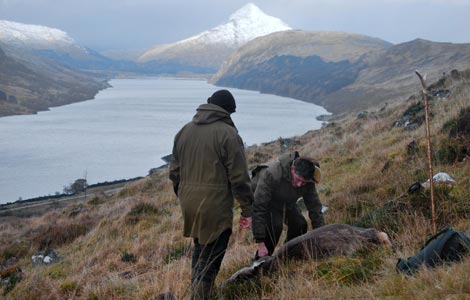Why is stalking so important?
Wild red deer are native to Scotland but they have no natural predators, so to protect the ecological and productive potential of the land and the deer themselves the numbers of red deer need to be carefully managed to a pre-defined level set by Scottish Natural Heritage.
Deer stalking is not only a skilled activity but also an essential part of the land management programme which helps maintain a strong, healthy population of younger hinds who will go on to successfully reproduce around April. During the red deer hind season between October 21st and February 15th all Estates are required to cull a set number of hinds and those estates will use that requirement to cull those hinds that are in poor condition and are often not strong enough to survive the winter. Hind stalking tends to be done by professional deer stalkers on their own but some estates let out some paid weeks where guests can be taken out on the hill by the professional as another welcome source of funds at a time of year when income can otherwise be difficult to come by.
I was lucky enough to be invited to the Reay Forest Estate in Sutherland in January to experience first hand what happens on a Highland estate in the depths of winter during the hind season. I set off north for the six hour drive through some of the most spectacular scenery you could ever hope to see with a mounting sense of awe and excitement at being out and about in countryside that literally takes your breath away.

First Day on the Hill
On our first morning, we were picked up by our qualified Stalker (Pete) who lives and breathes his passion for managing deer in a sustainable and ethical manner. He has been doing the job all his life (30 years on this estate) and it was apparent there was nothing he didn’t know about his beat and the surrounding countryside. He was dressed in the Estate’s own traditional tweed shooting attire, made in a local woollen mill in Sutherland which allows them to blends into the surrounding landscape on that specific Estate. The stalkers also wore a high-quality Gore-Tex jacket and over trousers for added waterproof protection – all finished off with Deerstalker hat.
We headed off in the Argo Cat with Pete and his assistant to do some target practice to ensure the rifle was zeroed properly, to get our eye in and to become familiar with the rifle. Once the stalker had assessed our accuracy and fitness we started our long anticipated ascent up what seemed like an impossibly steep rugged hill over gullies, burns and rock faces to get into an area where the stalker felt we would see deer given the wind and weather conditions we had on that particular day.
The Deer
The Hinds have an incredible sense of smell and on a windy day when that wind is constantly changing direction depending on the shape of the hillside, you need to outwit them and often have to climb high above them and then slowly advance into the wind to avoid being smelt (winded) by them. They also have acute hearing and mostly detect any unnatural sounds.
For this reason it is essential to wear noiseless clothing that doesn’t rustle and avoid the deer seeing any odd looking shapes ie a rifle sticking up in the air. It is important your clothing suits the surrounding area where you are stalking to help remain hidden and always move slowly, don’t smoke or use your phone!
Spying the Beasts
After a long bumpy Argo Cat ride where the scenery was spectacular rugged and a place of Geographic interest we suddenly stopped. We left the Argo Cat hidden and started scrambling methodically up the hill towards the snowline where some hinds had been spotted.
Generally, when the weather is bad the deer tend to come down the hill about 24 hours before that bad weather arrives so the stalkers always have an idea about the type of day that lies ahead, depending on the wind direction and weather forecast.
Pete walked ahead with a traditional looking fold away telescope which he used to spy the hinds. As we walked and took in the breath-taking surroundings the wind was blowing in all directions making our approach all the more difficult, but I soon realised how skilful Pete was at getting us close enough to take a shot.
The ground underfoot was tough going, mostly soggy Peat Hags, bogs and heather tufts with water running off the hill over smooth rocks, hidden by the long grass.
The Stalk
After an exhausting hike we suddenly stopped, a gentle hand signal from Pete came my way and the rifle was taken out of its case. I knew that it was time to start the long, slow ,silent crawl towards a small ridge to get into position.
Pete had identified an older, poor quality and poor looking Hind which was the one I was tasked with finding in my scope. Once I had located the Hind on the hill with my own eyesight I then had to find it in the high powered scope which is more difficult to do than it sounds.
Once in position the wind was tugging ferociously on the rifle and my heart was racing. Having never shot anything before I was apprehensive about getting it wrong, missing altogether or, worse still, injuring the hind. Pete had been great at showing me exactly where he would want me to aim when we were on the target before we set out and he reassured me that I was more than capable of taking the shot having been bang on target earlier.
When he knew I was ready he told me to take the shot and I duly gently squeezed the trigger and, to my relief, the hind dropped to the ground stone dead.
Pete told me that she would not have survived the winter and, when we got up to her, it was obvious that she was in really poor nick and would have died a prolonged death by starvation or cold or both so I was happy to have instantaneously put her down and, in doing so, to have been part of the vital management of the red deer population in the Highlands.
The End Product
After a full day on the hill we reunited with the Argo Cat, the hind was dragged off the hill and taken to the larder where they were clinically prepared for sale and collection by the local game dealer who would then prepare the resulting venison for wholesale.
Venison is one of the most organic, nutritious and fat free of all red meats and a good source of healthy protein and can be readily found in most butchers and supermarkets.

Other incredible wildlife in the Scottish Highlands mountains
Circling high above us we were privileged enough to see golden eagle flying on the thermals, as well as ravens who are always on the lookout for the gralloch. This is a really nutritious source of food in winter for birds of prey and other endangered species – a great by-product and benefit of stalking.
It is etiquette to never leave the gralloch near a public walkway and, if it is, to cover it with soil and peat. We also saw red squirrels, curlew, buzzards, kestrels, trails of pine martin and badger and plenty of red deer all of which were a real honour to see.


